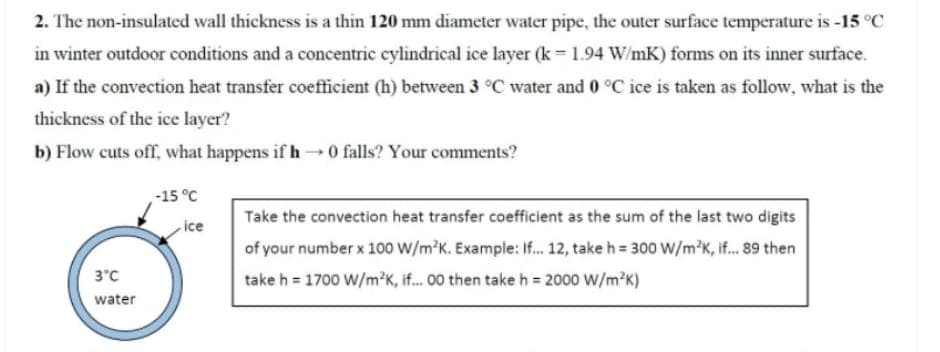2. The non-insulated wall thickness is a thin 120 mm diameter water pipe, the outer surface temperature is -15 °C in winter outdoor conditions and a concentric cylindrical ice layer (k=1.94 W/mK) forms on its inner surface. a) If the convection heat transfer coefficient (h) between 3 °C water and 0 °C ice is taken as follow, what is the thickness of the ice layer? b) Flow cuts off, what happens if h0 falls? Your comments? -15 °C Take the convection heat transfer coefficient as the sum of the last two digits ice
2. The non-insulated wall thickness is a thin 120 mm diameter water pipe, the outer surface temperature is -15 °C in winter outdoor conditions and a concentric cylindrical ice layer (k=1.94 W/mK) forms on its inner surface. a) If the convection heat transfer coefficient (h) between 3 °C water and 0 °C ice is taken as follow, what is the thickness of the ice layer? b) Flow cuts off, what happens if h0 falls? Your comments? -15 °C Take the convection heat transfer coefficient as the sum of the last two digits ice
Principles of Heat Transfer (Activate Learning with these NEW titles from Engineering!)
8th Edition
ISBN:9781305387102
Author:Kreith, Frank; Manglik, Raj M.
Publisher:Kreith, Frank; Manglik, Raj M.
Chapter2: Steady Heat Conduction
Section: Chapter Questions
Problem 2.49P
Related questions
Question
157896548

Transcribed Image Text:2. The non-insulated wall thickness is a thin 120 mm diameter water pipe, the outer surface temperature is -15 °C
in winter outdoor conditions and a concentric cylindrical ice layer (k = 1.94 W/mK) forms on its inner surface.
a) If the convection heat transfer coefficient (h) between 3 °C water and 0 °C ice is taken as follow, what is the
thickness of the ice layer?
b) Flow cuts off, what happens if h 0 falls? Your comments?
-15 °C
Take the convection heat transfer coefficient as the sum of the last two digits
ice
of your number x 100 W/m'K. Example: If. 12, take h = 300 W/m'K, if... 89 then
take h = 1700 W/m?K, if. 00 then take h = 2000 W/m?K)
3"C
water
Expert Solution
This question has been solved!
Explore an expertly crafted, step-by-step solution for a thorough understanding of key concepts.
Step by step
Solved in 3 steps with 3 images

Knowledge Booster
Learn more about
Need a deep-dive on the concept behind this application? Look no further. Learn more about this topic, mechanical-engineering and related others by exploring similar questions and additional content below.Recommended textbooks for you

Principles of Heat Transfer (Activate Learning wi…
Mechanical Engineering
ISBN:
9781305387102
Author:
Kreith, Frank; Manglik, Raj M.
Publisher:
Cengage Learning

Principles of Heat Transfer (Activate Learning wi…
Mechanical Engineering
ISBN:
9781305387102
Author:
Kreith, Frank; Manglik, Raj M.
Publisher:
Cengage Learning